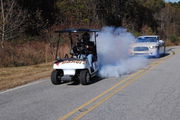

Anyone who’s ever played golf knows that hitting low scores is easier said than done. It’s not just about swinging hard or hitting perfect shots, but rather about making smarter decisions and playing to your strengths. So, how do you shoot lower scores? Here are five actionable tips to help you lower your handicap and make your time on the course much more enjoyable.
Watch What’s Trending Now!
Top Stories
John Daly Shares Harsh Reality of His Health as He Admits His ‘Career Is Declining’

PGA Tour Pros React Strongly as Brooks Koepka Breaks $100M LIV Golf Contract: ‘I Vote..’

Fatal Golf Cart Crash Shuts Down Section of U.S. Highway Near Lakeland

Nelly Korda, Charley Hull & More: How Your Favorite LPGA Stars Celebrated Christmas

LIV Golf CEO Breaks Silence as Brooks Koepka Exits Before Contract Expiry

1. Master Golf Course Management
One of the most overlooked elements of golf is course management. A good understanding of the course and your abilities can save you strokes more effectively than any technical adjustment.
ADVERTISEMENT
For example, instead of always aiming directly at the flag on every hole, evaluate the hole layout and choose a safer approach. If you’re faced with a difficult approach shot, sometimes it’s better to play conservatively—hit to a larger part of the green or lay up short of hazards. By doing this, you reduce the risk of landing in a bunker or water hazard and increase your chances of scoring well.
Think of each hole as a puzzle. The goal isn’t always to attack but to play the percentages. And remember, it’s not just about the driver; course management applies to every club in your bag, from tee to green.
ADVERTISEMENT
2. Focus on One Shot at a Time
Golf is a mental game as much as it is a physical one. The ability to focus on one shot at a time is a skill that all great players possess. How many times have you had a bad hole or made a mistake, only to let it affect your next shot? This kind of mental lapse can lead to big mistakes and ruined rounds.
Instead of dwelling on bad shots, take a deep breath and focus solely on your current shot. Great golfers don’t get caught up in thinking about the last hole or the one coming up. They are present, addressing the current shot with a clear mind. Remember, each shot is a fresh opportunity to execute well. Focusing on one shot at a time helps you block out distractions and remain calm under pressure, which is key to shooting low.
ADVERTISEMENT
3. Master Distance Control
Knowing how far you hit each club is one of the most valuable skills a golfer can develop. This not only helps you avoid over-hitting or under-hitting, but also improves your overall accuracy. Think about it: how often do you miss the green because you didn’t hit the right distance? A club that goes too far or too short can add strokes to your score.
Take time during your practice sessions to understand your distances. When you know how far each club can go, you can make more informed decisions on the course. This is particularly important when approaching the green or hitting into greens with narrow landing zones. Distance control lets you avoid hazards and find the right part of the green, making your birdie or par putt much easier.
ADVERTISEMENT
In addition, it’s important to know your limits. For instance, don’t try to force a shot with a club that you’re not comfortable with. It’s always better to choose a safer option and leave yourself a manageable shot rather than trying to reach a difficult target and risk making a costly mistake.
4. Play to Your Strengths
We all have different strengths when it comes to our game—whether it’s a powerful drive, a sharp short game, or consistent iron play. The key to shooting lower scores is playing to those strengths and not trying to play a game that isn’t suited for you.
ADVERTISEMENT
For instance, if you’re great with wedges but not so strong with your driver, focus on course management that allows you to set up easier wedge shots rather than forcing long drives that might put you in tough spots. On shorter par-4s, you might consider laying up with an iron or hybrid, putting yourself in the best position for an easier approach shot.
Playing to your strengths means understanding your abilities and making choices that maximize them. Don’t try to be a hero on every hole by attempting impossible shots. Instead, take what the course gives you and use your best skills to your advantage.
ADVERTISEMENT
5. Stay Calm and Think Strategically
Golf is a game that demands patience, and emotional control is crucial. It’s easy to get frustrated when things aren’t going your way, but maintaining composure and thinking strategically will help you make better decisions and avoid unnecessary mistakes.
For example, if you’re struggling with your tee shots, don’t force it. Consider switching to a 3-wood or hybrid for more control instead of going all-out with the driver. If you find yourself in a tough spot on a par 3, don’t rush to make a heroic shot; play conservatively, and aim for the center of the green. The game will reward you with fewer mistakes and a lower score if you remain calm and strategic.
Strategic thinking also involves knowing when to take risks and when to play it safe. If you’re on a hole where the risk outweighs the reward—perhaps with water hazards or bunkers—don’t be afraid to play for par. Remember that golf is a marathon, not a sprint, and saving strokes on the course is more important than trying to make every shot perfect.
ADVERTISEMENT
With these five tips, you’ll be on your way to lower scores and a much more enjoyable round of golf. It’s all about playing smarter, not harder.
ADVERTISEMENT
ADVERTISEMENT
ADVERTISEMENT

